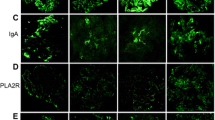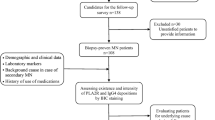Abstract
Background
Fibrillary glomerulonephritis (FGN) is a rare glomerular disease. DNAJB9 as a new reliable diagnostic marker for the diagnosis of FGN was discovered recently. To investigate the clinicopathological features and prognosis of DNAJB9-positive FGN, we report on a case series in a single center in China.
Methods
DNAJB9 immunohistochemistry was performed on renal biopsy samples from patients with FGN (n = 7), and non-FGN glomerular diseases (n = 27) were used as controls. The patients with DNAJB9-positive FGN were retrospectively analyzed.
Results
Strong DNAJB9 staining of glomerular extracellular deposits was observed in 6 cases of originally diagnosed FGN. One man and 5 women with a median age of 26 years were studied. The patients presented with renal insufficiency in 1 case, proteinuria in 6 cases, nephrotic syndrome in 3 cases, and microscopic hematuria in 2 cases. The histologic pattern was mesangial proliferative glomerulonephritis in 1 case and membranoproliferative glomerulonephritis in 5 cases. The glomerular deposits stained for polytypic IgG and both kappa and lambda in 3 cases, polytypic IgG without kappa or lambda in 1, monotypic IgG1-kappa in 1 and IgG1-lambda in 1. Extraglomerular deposits were identified in all cases. Congo red positivity was observed in 3 cases. All of the patients received renin–angiotensin–aldosterone system blockade and 5 of them received glucocorticoid and/or immunosuppression. At a median time of 36.2 months after biopsy, 2 cases had partial remission, 3 cases displayed no remission, and 1 case progressed to end-stage renal disease.
Conclusions
Extraglomerular deposits in the FGN were common. Monotypic FGN was found in young patients with a favorable renal outcome.



Similar content being viewed by others
References
Nasr SH, Fogo AB (2019) New developments in the diagnosis of fibrillary glomerulonephritis. Kidney Int 96(3):581–592. https://doi.org/10.1016/j.kint.2019.03.021
Yu XJ, Zhang X, Li DY, Wang SX, Zhou FD, Zhao MH (2019) Renal pathologic spectrum and clinical outcome of monoclonal gammopathy of renal significance: a large retrospective case series study from a single institute in China. Nephrology (Carlton). https://doi.org/10.1111/nep.13633
Liu X, Liu H, Zhao Z, Zhang Z, Ding X (2013) Fibrillary glomerulonephritis complicated by membranous nephropathy in a patient with tuberculosis. Int Urol Nephrol 45(5):1501–1504. https://doi.org/10.1007/s11255-012-0236-7
Li XM, Ye WL, Wen YB, Li H, Chen LM, Liu DY, Zeng XJ, Li XW (2009) Glomerular disease associated with Takayasu arteritis: 6 cases analysis and review of the literature. Chin Med Sci J 24(2):69–75. https://doi.org/10.1016/s1001-9294(09)60063-8
Dasari S, Alexander MP, Vrana JA, Theis JD, Mills JR, Negron V, Sethi S, Dispenzieri A, Highsmith WE Jr, Nasr SH, Kurtin PJ (2018) DnaJ heat shock protein family B member 9 Is a novel biomarker for fibrillary GN. J Am Soc Nephrol 29(1):51–56. https://doi.org/10.1681/ASN.2017030306
Andeen NK, Yang HY, Dai DF, MacCoss MJ, Smith KD (2018) DnaJ homolog subfamily B member 9 is a putative autoantigen in fibrillary GN. J Am Soc Nephrol 29(1):231–239. https://doi.org/10.1681/ASN.2017050566
Nasr SH, Vrana JA, Dasari S, Bridoux F, Fidler ME, Kaaki S, Quellard N, Rinsant A, Goujon JM, Sethi S, Fervenza FC, Cornell LD, Said SM, McPhail ED, Herrera Hernandez LP, Grande JP, Hogan MC, Lieske JC, Leung N, Kurtin PJ, Alexander MP (2018) DNAJB9 is a specific immunohistochemical marker for fibrillary glomerulonephritis. Kidney Int Rep 3(1):56–64. https://doi.org/10.1016/j.ekir.2017.07.017
Kidney Disease: Improving Global Outcomes (KDIGO) Glomerulonephritis Work Group (2012) KDIGO Clinical Practice Guideline for Glomerulonephritis. Chapter 12: Lupus nephritis. Kidney Int Suppl 2(2):221–232. https://doi.org/10.1038/kisup.2012.25
Nasr SH, Sirac C, Bridoux F, Javaugue V, Bender S, Rinsant A, Kaaki S, Pinault E, Dasari S, Alexander MP, Said SM, Hogan JJ, Dispenzieri A, Touchard G, McPhail ED, Leung N (2019) Heavy chain fibrillary glomerulonephritis: a case report. Am J Kidney Dis 74(2):276–280. https://doi.org/10.1053/j.ajkd.2019.01.032
Andeen NK, Troxell ML, Riazy M, Avasare RS, Lapasia J, Jefferson JA, Akilesh S, Najafian B, Nicosia RF, Alpers CE, Smith KD (2019) Fibrillary glomerulonephritis: clinicopathologic features and atypical cases from a multi-institutional cohort. Clin J Am Soc Nephrol 14(12):1741–1750. https://doi.org/10.2215/CJN.03870319
Fogo A, Qureshi N, Horn RG (1993) Morphologic and clinical features of fibrillary glomerulonephritis versus immunotactoid glomerulopathy. Am J Kidney Dis 22(3):367–377
Rosenstock JL, Markowitz GS, Valeri AM, Sacchi G, Appel GB, D’Agati VD (2003) Fibrillary and immunotactoid glomerulonephritis: distinct entities with different clinical and pathologic features. Kidney Int 63(4):1450–1461. https://doi.org/10.1046/j.1523-1755.2003.00853.x
Rosenstock JL, Markowitz GS (2019) Fibrillary glomerulonephritis: an update. Kidney Int Rep 4(7):917–922. https://doi.org/10.1016/j.ekir.2019.04.013
Leung N, Bridoux F, Batuman V, Chaidos A, Cockwell P, D’Agati VD, Dispenzieri A, Fervenza FC, Fermand JP, Gibbs S, Gillmore JD, Herrera GA, Jaccard A, Jevremovic D, Kastritis E, Kukreti V, Kyle RA, Lachmann HJ, Larsen CP, Ludwig H, Markowitz GS, Merlini G, Mollee P, Picken MM, Rajkumar VS, Royal V, Sanders PW, Sethi S, Venner CP, Voorhees PM, Wechalekar AD, Weiss BM, Nasr SH (2019) The evaluation of monoclonal gammopathy of renal significance: a consensus report of the International Kidney and Monoclonal Gammopathy Research Group. Nat Rev Nephrol 15(1):45–59. https://doi.org/10.1038/s41581-018-0077-4
Alexander MP, Dasari S, Vrana JA, Riopel J, Valeri AM, Markowitz GS, Hever A, Bijol V, Larsen CP, Cornell LD, Fidler ME, Said SM, Sethi S, Herrera Hernandez LP, Grande JP, Erickson SB, Fervenza FC, Leung N, Kurtin PJ, Nasr SH (2018) Congophilic fibrillary glomerulonephritis: a case series. Am J Kidney Dis 72(3):325–336. https://doi.org/10.1053/j.ajkd.2018.03.017
Nasr SH, Dasari S, Lieske JC, Benson LM, Vanderboom PM, Holtz-Heppelmann CJ, Giesen CD, Snyder MR, Erickson SB, Fervenza FC, Leung N, Kurtin PJ, Alexander MP (2019) Serum levels of DNAJB9 are elevated in fibrillary glomerulonephritis patients. Kidney Int 95(5):1269–1272. https://doi.org/10.1016/j.kint.2019.01.024
Nasr SH, Valeri AM, Cornell LD, Fidler ME, Sethi S, Leung N, Fervenza FC (2011) Fibrillary glomerulonephritis: a report of 66 cases from a single institution. Clin J Am Soc Nephrol 6(4):775–784. https://doi.org/10.2215/CJN.08300910
Sekulic M, Nasr SH, Grande JP, Cornell LD (2017) Histologic regression of fibrillary glomerulonephritis: the first report of biopsy-proven spontaneous resolution of disease. Clin Kidney J 10(6):738–741. https://doi.org/10.1093/ckj/sfx045
Funding
This work was supported by National Key Research and Development Program of China (2016YFC0901202), the National Natural Science Foundation of China (81800629).
Author information
Authors and Affiliations
Contributions
All authors have reviewed and contributed to this manuscript. The individual contribution of each co-author was as follows: SL, CZ contributed to research idea and study design; SL, DC, DL, FX, MZ, FY, XZ, PL contributed to data acquisition; SL, CZ, MZ contributed to pathological analysis; SL, DC, MZ contributed to data analysis and interpretation; CZ contributed to supervision and mentorship.
Corresponding author
Ethics declarations
Conflicts of interest
All authors declare that there is no conflict of interests.
Ethics approval
All procedures performed in studies involving human participants were in accordance with the ethical standards of the institutional and/or national research committee and with the 1964 Helsinki Declaration and its later amendments or comparable ethical standards.
Additional information
Publisher's Note
Springer Nature remains neutral with regard to jurisdictional claims in published maps and institutional affiliations.
Rights and permissions
About this article
Cite this article
Liang, S., Chen, D., Liang, D. et al. Clinicopathological characteristics and outcome of patients with fibrillary glomerulonephritis: DNAJB9 is a valuable histologic marker. J Nephrol 34, 883–892 (2021). https://doi.org/10.1007/s40620-020-00783-4
Received:
Accepted:
Published:
Issue Date:
DOI: https://doi.org/10.1007/s40620-020-00783-4




